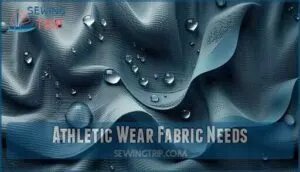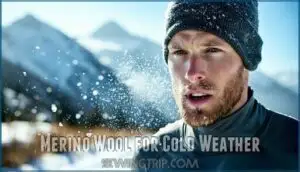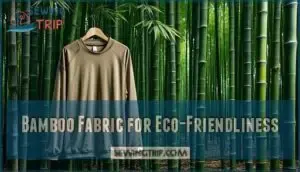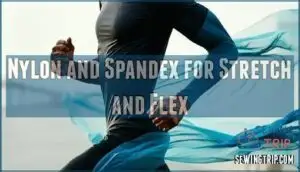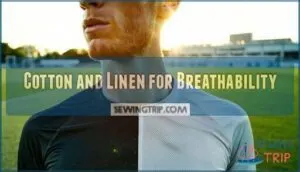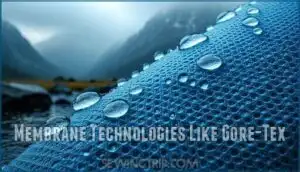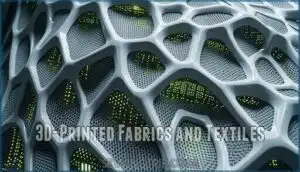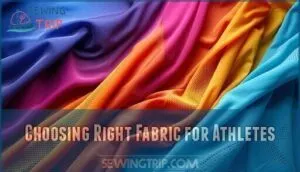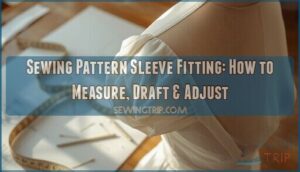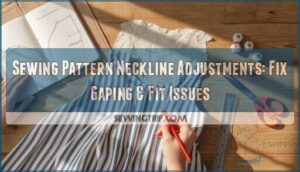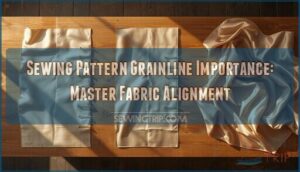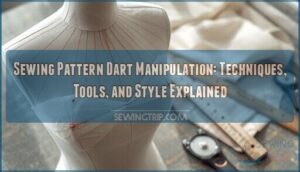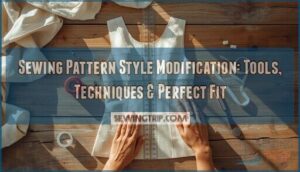This site is supported by our readers. We may earn a commission, at no cost to you, if you purchase through links.
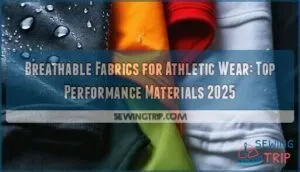
Polyester leads the pack with moisture-wicking properties that pull sweat away from your skin. Nylon offers durability and stretch, while merino wool provides natural odor resistance and temperature control.
Bamboo fabric brings eco-friendly breathability, and cotton blends work for lighter activities. The key is finding fabrics with loose weaves or mesh panels that allow air circulation.
Modern synthetic blends often combine multiple materials for superior performance. Your fabric choice can make or break your workout comfort – and there’s more to think about than just breathability alone.
Table Of Contents
Key Takeaways
- Choose moisture-wicking synthetics like polyester or merino wool – they’ll pull sweat away from your skin and dry faster than cotton, keeping you comfortable during intense workouts
- Match fabric to your activity level – high-intensity exercises need advanced moisture management, while lighter activities can work with basic breathable materials like cotton blends
- Consider blended fabrics for best performance – combinations like nylon-spandex or cotton-polyester give you stretch, durability, and breathability in one package
- Invest in quality breathable fabrics – they’ll maintain their moisture-wicking properties longer through repeated washing and wear, making them worth the higher upfront cost
Breathable Fabric Types
When you’re choosing athletic wear, you’ll encounter five main fabric types that affect your comfort and performance.
Natural fibers like cotton offer breathability, synthetic materials like polyester provide moisture management, blends combine benefits from both categories.
Specialized moisture-wicking fabrics actively move sweat away from your skin, and ventilation systems built into fabrics create airflow channels for enhanced cooling.
Natural Fibers Like Cotton
While cotton might seem like an old-school choice for athletic wear, this natural fiber offers unique benefits you shouldn’t overlook.
Cotton’s breathable structure allows air circulation, though it lacks advanced moisture-wicking capabilities of synthetic alternatives.
- Cotton Comfort: Soft texture prevents chafing during extended workouts
- Organic Cotton: Chemical-free production appeals to environmentally conscious athletes
- Cotton Durability: Natural fibers withstand repeated washing better than delicate synthetics
However, cotton alternatives often outperform traditional cotton in high-intensity activities where moisture management becomes critical for performance.
Synthetic Fibers Like Polyester
Polyester breathability transforms your athletic experience through advanced engineering.
These synthetic fabrics excel at moisture-wicking, pulling sweat away from skin faster than natural fibers.
Microfiber advantages include superior durability and quick-drying properties that keep you comfortable during intense workouts.
Performance impact shows in reduced chafing and better temperature control.
However, environmental concerns about synthetic blends remain valid considerations for eco-conscious athletes, particularly regarding the environmental impact.
Blends of Natural and Synthetic Fibers
You’ll access superior fiber performance when you combine natural and synthetic materials in athletic wear.
These blends deliver the best of both worlds for serious athletes.
- Cotton-polyester blends offer breathable fabrics with enhanced durability
- Merino wool-synthetic combinations provide moisture-wicking while maintaining comfort factors
- Bamboo-nylon mixes reduce environmental impact without sacrificing performance
- Linen-spandex blends create flexible, breathable solutions for hot climates
- Cost analysis shows blended synthetic fabric options offer better value than pure materials
Moisture-Wicking Fabrics
Three revolutionary wicking mechanisms transform how you stay dry during intense workouts. Synthetic fibers use capillary action to pull moisture through fabric construction, while chemical treatments enhance performance testing results.
Advanced moisture-wicking fabric delivers superior breathable athletic wear through specialized performance apparel design. This athletic clothing provides exceptional moisture management while considering environmental impact.
To guarantee comfort, these fabrics often utilize a hydrophilic inner layer to absorb and spread sweat.
| Technology | Drying Time |
|---|---|
| 8C Microporous | 8-10 minutes |
| Standard Polyester | 25 minutes |
| Traditional Cotton | 45+ minutes |
| Merino Wool | Moderate |
| Bamboo Fabric | Fast |
Ventilation Systems in Fabrics
Advanced fabric ventilation systems control airflow through strategic pore size manipulation and weave structures.
You’ll find mesh panels, laser-cut perforations, and engineered layering effects that optimize air circulation.
These fabric construction methods enhance air permeability by creating dedicated airflow mechanisms.
Smart moisture transport channels work with fabric ventilation to pull sweat away while maintaining consistent air flow throughout your workout.
Advanced fabric ventilation systems and air circulation mechanisms are designed to work together to provide optimal comfort during exercise.
Athletic Wear Fabric Needs
When you’re choosing athletic wear, your fabric needs extend far beyond basic comfort.
You’ll require materials that actively manage moisture, regulate temperature, provide flexibility, maintain durability, and offer superior breathability to support peak performance during intense physical activity.
Sweat Management and Evaporation
When you’re pushing your limits during intense workouts, your body’s natural cooling system kicks into high gear.
Moisture wicking fabrics pull sweat away from your skin through advanced fabric porosity, creating faster evaporation rates that deliver an instant cooling effect.
These breathable fabrics for exercise clothing use specialized moisture management fabrics that transport perspiration to the fabric’s outer surface.
The result is enhanced perspiration evaporation and superior odor control that keeps you fresh throughout your training session.
Temperature Regulation and Comfort
Temperature regulation separates good athletic wear from great performance gear.
Your body temperature fluctuates during exercise, and breathable fabrics provide thermal comfort by allowing heat to escape while maintaining ideal skin conditions.
Proper thermal regulation prevents overheating and keeps you comfortable.
- Moisture Control: Breathable fabrics transport sweat away from skin, preventing that clammy feeling
- Fabric Weight: Lighter materials enhance airflow while heavier fabrics trap heat unnecessarily
- Odor Reduction: Better ventilation reduces bacterial growth that causes unpleasant smells
Flexibility and Mobility in Fabric
When you’re pushing your body to its limits, you need stretch fabrics that move with you.
Freedom movement becomes your ally when fabric construction allows unrestricted motion. Body conforming materials enhance agility by adapting to every twist and turn.
Breathable fabrics athletic wear should bend without breaking your stride, giving you enhanced agility for peak sports performance. Many athletes now prefer moisture-wicking nylon for its durability.
Durability and Longevity of Fabric
Durability matters when you’re pushing your gear to the limit. Quality performance fabrics withstand repeated use while maintaining their breathable properties and structural integrity throughout countless workouts.
- Wash Durability – Fabrics retain shape and breathability after multiple wash cycles
- Abrasion Resistance – Material withstands friction from equipment and movement
- Pilling Resistance – Surface stays smooth without forming fabric balls
- Colorfastness Testing – Colors remain vibrant despite sweat and washing
- Seam Strength – Reinforced stitching prevents tears during intense activity
Breathability and Air Permeability
Fabric ventilation technology determines how well your athletic wear handles intense workouts.
Air permeability measures airflow mechanisms through fabric structures, while pore size controls moisture transport efficiency.
Testing methods evaluate fabric density to guarantee superior air circulation.
Breathable fabrics with proper air exchange prevent overheating, keeping you comfortable during peak performance activities, utilizing fabric ventilation technology and ensuring moisture transport efficiency.
Best Fabrics for Athletic Wear
You’ll find that choosing the right athletic fabric can make or break your workout performance and comfort levels.
The best breathable materials combine moisture management, temperature control, and flexibility to keep you moving efficiently during any activity.
Merino Wool for Cold Weather
When winter winds bite, merino wool becomes your shield against the elements.
When temperatures drop, merino wool wraps you in nature’s perfect performance armor.
This natural performance textile delivers unmatched cold protection while maintaining breathability that synthetic alternatives can’t match.
Here’s why merino wool dominates cold-weather gear:
- Wool insulation traps air in crimped fibers, keeping you warm even when damp
- Moisture-wicking fabric absorbs 30% its weight without feeling wet
- Odor resistance naturally fights bacteria for multi-day freshness
- Layering system compatibility works as base or mid-layer
- Wool sourcing from renewable sheep makes it environmentally sustainable
This breathable material regulates temperature automatically, preventing overheating during intense activity while maintaining warmth during rest periods.
For peak performance, consider using merino wool base layers.
Bamboo Fabric for Eco-Friendliness
Bamboo fabric revolutionizes athletic wear through sustainable production and exceptional breathability.
You’ll discover superior moisture-wicking fabric performance while supporting eco-friendly manufacturing.
Bamboo sourcing guarantees minimal environmental impact, while biodegradability factors make disposal guilt-free.
Shoppers can find sustainable bamboo options online.
| Feature | Bamboo Benefit | Athletic Impact |
|---|---|---|
| Breathability | Micro-gaps allow airflow | Keeps you cooler |
| Antimicrobial | Natural bamboo kun | Reduces odor buildup |
| Moisture Management | Rapid sweat transfer | Stays dry longer |
Bamboo durability withstands intense workouts while eco-friendly dyes maintain vibrant colors.
This textile combines performance with environmental responsibility, making your activewear choices matter beyond the gym, supporting a guilt-free and responsible approach to fashion.
Nylon and Spandex for Stretch and Flex
When you need gear that moves with you, nylon and spandex deliver unmatched stretch performance.
These fabric blends create athletic wear that won’t hold you back during intense workouts.
- Nylon durability withstands repeated washing and high-impact activities
- Spandex recovery snaps back to original shape after stretching
- Compression benefits support muscles while maintaining breathable fabrics
This combination offers superior moisturewicking properties and fabric performance for demanding activewear applications.
You can find a variety of nylon spandex options.
Polyester and Elastane for Performance
Unlike single-fiber options, polyester and elastane performance blends give you the best of both worlds.
These breathable fabrics for sports combine polyester’s moisture-wicking capabilities with elastane’s stretch properties.
Performance blends deliver superior fabric durability while maintaining breathable fabric for athletic performance.
Cost analysis shows these breathable fabrics for activewear offer excellent value, making them ideal breathable fabric for training and sports performance applications.
Cotton and Linen for Breathability
Cotton and linen deliver natural breathability through their loose weave structures, making them solid choices for low-intensity workouts.
Cotton properties include excellent moisture absorption, while linen benefits from superior air circulation. However, these breathable fabrics natural fibers can become heavy when wet, limiting their performance potential.
Specialized weaves enhance ventilation in performance fabrics.
- Weave impact: Open fiber structures in cottonlinen blend materials allow maximum airflow but may compromise moisture-wicking speed compared to synthetic alternatives
- Blending options: Combining cotton with synthetic fibers creates breathable clothing for athletes that balances natural comfort with enhanced performance characteristics
- Environmental impact: Natural breathable fabrics offer sustainable alternatives to petroleum-based synthetics, though they require more water and land resources during production
Innovative Fabric Technologies
You’re entering an exciting era where fabric technology transforms athletic performance through cutting-edge innovations that actively respond to your body’s needs.
From membrane systems that breathe with you to smart textiles that monitor your workout, these breakthrough materials represent the future of athletic wear engineering, utilizing cutting-edge innovations.
Membrane Technologies Like Gore-Tex
When you’re pushing your limits on the mountain, membrane technologies like Gore-Tex become your shield against the elements.
These breathable materials use micropore technology to create waterproof breathability—tiny pores that block water droplets while allowing sweat vapor to escape.
Gore-Tex alternatives like FUTURELIGHT and DryVent offer similar membrane durability with varying environmental impact.
Performance materials with advanced textile technology give you the freedom to focus on your workout, not weather worries, utilizing breathable materials.
Microfiber and Nanotechnology
Microfiber weaves create ultra-fine synthetic fibers that enhance moisture-wicking fabric performance through increased surface area.
Nano-enhanced wicking technology uses antimicrobial nanoparticles to boost sweat transfer while preventing odor buildup in performance textiles.
- Smart textiles with embedded nanoparticles provide real-time performance feedback
- Textile technology combines microfiber structure with nanotechnology for superior breathability
- Fabric technology delivers antimicrobial protection without compromising comfort
3D-Printed Fabrics and Textiles
Breaking free from traditional manufacturing constraints, 3D-printed technical fabrics revolutionize athletic wear through Customizable Designs and Complex Geometries impossible with conventional methods.
This textile innovation enables Performance Enhancement by creating precise ventilation channels and targeted support zones.
Material science advances allow Sustainable Materials integration, reducing waste through exact production quantities.
The use of shiny fabric texture can also enhance the aesthetic appeal of these innovative designs.
Scalable Production capabilities let you access cutting-edge fabric technology previously limited to elite athletes.
Smart Fabrics With Sensors and Feedback
Smart fabrics with sensor integration revolutionize athletic apparel by embedding conductive yarns that monitor heart rate, muscle activity, and body temperature.
These breathable fabrics provide real-time feedback through performance monitoring systems, enabling data analysis for optimized training.
Adaptive clothing responds to sweat detection, automatically adjusting ventilation in activewear while maintaining comfort during intense sports activities.
Sustainable and Eco-Friendly Fabric Options
Eco-conscious athletes can now choose from recycled polyester made from plastic bottles, bio-based materials from renewable sources, and ethically produced textiles.
These sustainable certifications guarantee reduced waste while maintaining breathable fabrics’ performance.
You’ll find these materials offer the same moisture-wicking properties as traditional synthetics, but with a lighter environmental footprint for your athletic clothing.
Choosing Right Fabric for Athletes
Selecting the right athletic fabric depends on five key factors that directly impact your performance and comfort.
You’ll need to match fabric properties to your specific sport, climate conditions, personal preferences, budget constraints, and quality requirements for ideal results, considering complete concepts that enhance your athletic experience.
Considering Climate and Weather Conditions
Climate dictates your fabric choice more than you might think.
Hot, humid conditions demand lightweight breathable fabrics with superior moisture-wicking properties, while cold weather requires insulating materials that maintain breathability.
Seasonal fabrics should offer UV protection for summer outdoor activities and wind resistance for harsh conditions.
Consider humidity levels when selecting temperature regulation features – your comfort depends on matching fabric technology to environmental demands.
Activity Level and Intensity of Exercise
Your exercise intensity directly impacts your fabric performance needs.
Intense workouts demand fabrics that work as hard as you do.
High-intensity workouts generate greater sweat rates and elevated body temperature, requiring superior breathable fabric for athletic performance.
Low-intensity activities allow more fabric flexibility.
Match your sports performance demands to fabric capabilities—intense training needs advanced moisture-wicking materials while casual exercise tolerates basic breathable fabric for exercise options.
Personal Preference and Comfort Level
Your fabric choice depends on what feels right against your skin and suits your activity type.
Some athletes prefer the soft fabric feel of merino wool, while others choose synthetic breathable fabric for comfort during intense workouts.
Consider your skin sensitivity when selecting breathable clothing – certain textures might cause discomfort during all-day wear.
Your fit preference and layering needs also influence comfort levels in different breathable fabric options. For instance, athletes might consider breathable cotton options for casual wear.
Budget and Cost of Fabric and Clothing
Your wallet doesn’t have to break for quality sports clothing.
Budget brands offer solid activewear materials at reasonable clothing pricepoints, while discount options help stretch your dollar further.
Focus on cost durability – cheaper workout clothes that last longer provide better value than premium athletic wear fabric that wears out quickly.
Smart shopping wins every time.
Brand and Quality of Athletic Wear
Established brands often prioritize brand reputation through rigorous quality control and extensive fabric testing, while newer companies may offer competitive price point options.
Consider these factors when evaluating athletic wear breathable fabrics:
- Brand Reputation – Proven track record with breathable fabrics technology
- Quality Control – Consistent performance across product lines
- Fabric Testing – Independent verification of sportswear breathable fabrics claims
- Athlete Endorsements – Professional validation of activewear breathable fabrics
- Price Point – Value balance for athletic wear breathable fabrics performance
The given list of factors provides a comprehensive approach to assessing breathable fabrics in athletic wear, ensuring that consumers can make informed decisions based on their priorities, whether it be brand reputation, quality control, or price point.
Frequently Asked Questions (FAQs)
What is the most breathable fabric for activewear?
Merino wool magnificently manages moisture while you’re moving, making it the most breathable fabric for activewear.
You’ll stay cool and comfortable as this natural fiber wicks sweat efficiently and resists odors better than synthetic alternatives, with merino wool being a key factor in this process.
What type of fabric is best for athletic wear?
You’ll want moisture-wicking synthetic blends or merino wool for peak performance. These materials pull sweat away from your skin, dry quickly, and resist odors during intense workouts.
What is the best fabric to wear if you sweat a lot?
Moisture-wicking synthetic fabrics like polyester blends work best for heavy sweating.
They’ll pull sweat away from your skin and let it evaporate quickly, keeping you drier and more comfortable during intense workouts.
What is the best fabric for hot weather exercise?
Synthetic moisture-wicking fabrics like polyester blends excel in hot weather workouts. They pull sweat away from your skin, dry quickly, and won’t cling when drenched, keeping you cooler than cotton.
How often should athletic clothing be washed?
Wash your athletic gear after every workout session. Sweat, bacteria, and oils accumulate quickly in performance fabrics, breaking down fibers and creating odors that won’t budge.
Can breathable fabrics cause skin irritation or allergies?
Breathable fabrics can trigger skin irritation or allergies in sensitive individuals.
Synthetic materials may trap moisture, creating bacterial growth.
Natural fibers generally cause fewer reactions, but you’ll want to test new fabrics gradually.
Do breathable fabrics lose effectiveness over time?
Yes, you’ll notice breathable fabrics gradually losing their effectiveness. Repeated washing, wear, and fabric treatments break down the microscopic pores that allow airflow, reducing moisture-wicking performance over time.
How to properly care for moisture-wicking clothing?
Turn garments inside-out, use cold water, skip fabric softeners, air-dry when possible, and store properly. These steps preserve the synthetic fibers’ moisture-wicking properties and extend your athletic wear‘s performance lifespan.
Are expensive breathable fabrics worth the cost?
Like choosing between a sturdy oak and flimsy plywood for your foundation, expensive breathable fabrics often deliver superior moisture management, durability, and comfort.
That justify their higher price for serious athletes and frequent users.
Conclusion
Understanding fabric science reveals that moisture transport mechanisms directly impact athletic performance during intense physical activity.
Choosing the right breathable fabrics for athletic wear transforms your workout experience completely. You’ll perform better when your clothing works with your body’s natural cooling system rather than against it.
Modern synthetic blends, merino wool, and bamboo fabrics offer superior moisture management compared to traditional materials.
Your investment in quality breathable fabrics for athletic wear pays dividends through enhanced comfort, reduced chafing, and improved temperature regulation during every training session, resulting in overall better athletic performance.
- https://www.paramitadesigns.com/blogs/news/why-fabric-matters-in-activewear-breathability-comfort-and-sustainability
- https://coreculture.com/blogs/product-education/your-guide-to-the-most-breathable-fabrics-perfect-for-working-out-sweating-and-moving
- https://blily.in/the-power-of-breathable-fabric/
- https://www.challengerteamwear.com/the-importance-of-lightweight-and-breathable-fabrics-in-sportswear/
- https://www.thenorthface.com/en-us/about-us/technology-innovation/technology

